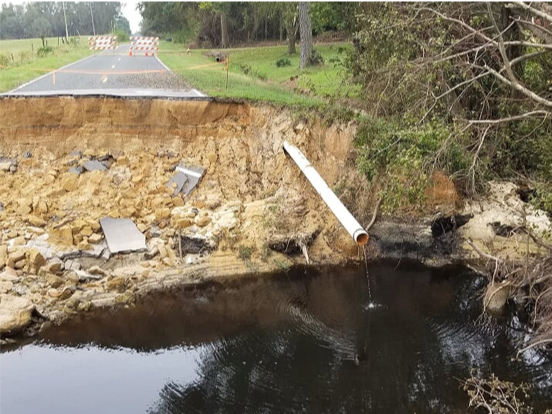By Connor LaMontagne
Connor LaMontagne is a PhD student in the Department of Environmental Sciences and Engineering at the Gillings School of Global Public Health at UNC-Chapel Hill.
Hurricane Florence and Water Quality Impacts
Imagine evacuating your home to escape a storm – maybe you actually did so during the recent hurricane. Now imagine returning to your home to find foamy, murky, foul-smelling water filling your yard. This was the reality for one Sampson County resident who spoke with my labmates and me on our recent sampling trip around Eastern North Carolina. It was, we expected, an example of the dangerous conditions that brought us out there in the first place.
Hurricane Florence was a massive storm – over 400 miles across – that dumped unprecedented amounts of rain and caused severe flooding in parts of the state. Our lab, led by Dr. Jill Stewart, focuses on water quality, and since the ability of flooding to contaminate water sources is well-documented, we knew we could play an important role in understanding the spread of these contaminants and the duration of their impacts.

Water in Eastern NC is particularly vulnerable to contamination by human and animal feces from several sources, including wastewater treatment plants, damaged sewage pipes (see image above), and commercial animal farms. For instance, a number of waste lagoons on hog farms failed or overflowed in response to Florence. Furthermore, due to humanity’s reliance on antibiotics, contamination from these sources may also spread antibiotic resistant bacteria through the environment. With all this in mind, we decided to measure fecal indicator bacteria, pathogens, and the presence of antibiotic resistance in surface waters around Eastern NC.
Sampling in the Field
Our group and others at UNC have a history of working in the area, so we were able to quickly mobilize resources and revisit sites we had studied prior to the storm. After a few days of preparation, four of us traveled to the lab before sunrise, packed a rental truck full of supplies, and headed out east. At each site, we tested water for properties like temperature, pH and oxygen content, and collected samples in sterile, screwcap bottles for microbiological testing back at the lab. We were also sure to note characteristics of the site itself, including appearance and flow of the water and what animals could be found. Such details may not seem necessary, but they can be quite helpful in making sense of our results, in understanding why certain sites may have had more or less microbial contamination than others.
It was an exhausting day – I didn’t get home until about 9 p.m. But it was worth the trip, and it provided a firsthand view of the many impacts of severe flooding, including a collapsed bridge and swarms of aggressive mosquitoes. It was a fascinating reminder of the far-reaching power of storms like Florence.

Protecting Public Health
Analysis of the samples began promptly the next morning and included determining the abundance of E. coli – a bacterium commonly used as an indicator of fecal contamination – and the pathogen Salmonella. In the future, we will analyze the DNA of these organisms to determine how common antibiotic resistance is at our sites, and we plan to return to the sites on a second sampling run to assess the time needed for the water to return to normal. Furthermore, multiple groups at UNC and other institutions are using samples from our trip to study additional types of contamination, like heavy metals.
If you think about threats to public health in a developed nation like the US, water quality may not be the first that comes to mind. This is thanks to the variety of systems put in place to prevent humans from interacting with contaminated water. Yet, major storms like Hurricane Florence can overwhelm these systems.
Our lab continues to work to understand the threats this poses to human health. Cross-discipline research from our lab and several others aims to provide a more complete picture of the effects of flooding on water quality, and the results we generate can be used to inform strategies for protecting public health. It is a prime example of the concept of One Health, which recognizes that the well-being of humans, animals, and the environment are all intimately connected. One Health thinking demands the collaboration of many fields to effectively address global issues – a notion that would benefit plenty of pursuits beyond health.

